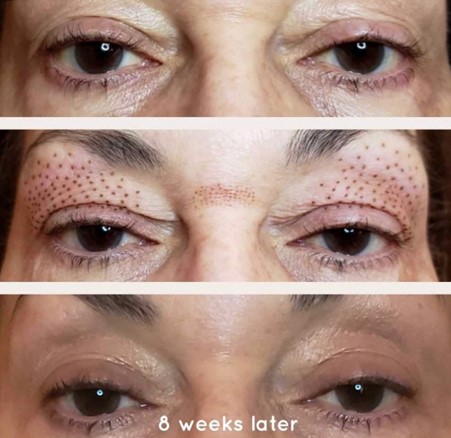The skin around your eyes is one of the first areas to show signs of aging. That’s partly because the skin in those areas is very thin, making it easier for lines, wrinkles, and sagging to occur. Unfortunately, when your eyes look old and worn, it can wind up aging the rest of your face, too. The next thing you know, you’re looking a lot older than you want to look — and a lot older than you feel.
The science of Plexr
Also called a plasma eye lift, Plexr uses plasma energy to create tiny areas of controlled damage in sagging, wrinkled areas of skin. These tiny wounds trigger your skin’s natural healing response. As part of this response, your body produces more collagen, which is a building block of youthful skin that helps skin heal and regenerate.
Plexr’s plasma energy vaporizes excess skin, reducing sagging in the eyelids and around the eye area. Because Plexr isn’t a surgical procedure, it doesn’t require general anesthesia or sutures, and there are no surgical risks to worry about.
Plexr’s technology enables to achieve very natural results based on your individual anatomy and treatment goals. Plexr can be a great treatment for people who want to:
- Smooth out wrinkles
- Eliminate or reduce sagging around the eyes
- Tighten droopy lids
- Rejuvenate an aging or worn-looking eye area
Plus, Plexr can also eliminate severe sagging that may interfere with your vision.
What to expect with Plexr treatment
Before your treatment, Dr. Belalcazar numbs the area, so you can stay relaxed and comfortable throughout your visit. Once your eyelids are numbed, he uses the handheld Plexr device to create a series of tiny microwounds throughout the treatment area. Your treatment can take up to an hour or as little as 20 minutes, depending on the size of the area being treated.
Rejuvenate your eye area without surgery
Plexr is associated with very high levels of patient satisfaction. In fact, in one study of 80 patients undergoing Plexr for eyelid tightening, every patient rated their satisfaction at the highest level, using a 1-5 scoring system.
Pre and Post Treatment Procedure for PLASMA FIBROBLAST
Fibroblast Candidacy
Fibroblast (Plasma Skin Tightening) is not suitable for everyone. If you are considering Plasma Skin Tightening, you should be in good health at the time of the appointment, with no pre-existing health conditions. Ideal candidates for this cosmetic procedure are those with fair to medium skin tones with lax, crepe-like skin around the eyes, neck, tummy, mouth, or targeted area for the treatment. Fibroblast will not effect fat cells. A good candidate must not be prone to keloid scars, have diabetes, a healing disorder, lymphatic draining issues, history of hyperpigmentation, wear a pacemaker, be pregnant or be breastfeeding.
This treatment is only recommended on light-medium dark skin tones (FitzPatrick Scale 1-3 and sometimes 4/5). If you are a number 3/4/5, you may be more prone to hyper-pigmentation, which isn’t necessarily permanent. People with number 3, 4 and 5 complexions are recommended to get a patch test in desired treatment area(s) to see how your skin responds. Anyone with a darker complexion (6) is at risk for hyperpigmentation. Regardless of your FitzPatrick Skin Type or if you are not sure if you are prone to hyperpigmentation, a patch test is recommended for everyone as hyperpigmentation and/or texture can be a risk for everyone.
Preparation
Contact lenses must be removed when performing treatment on the upper eyelids. Skin should not be inflamed in the area we are treating prior to procedure. If you have a sunburn/suntan, the treatment should be postponed for up to 8 weeks or until tan/burn signs disappear. Eyelash extensions receiving upper or lower eyelid treatment MUST have lashes removed prior to treatment, they can be reapplied after 8 weeks.
Refrain from using topical agents that may increase sensitivity of the skin 2 -3 days before treatment. These products include Retinoids, Exfoliants and/or exfoliating devices, Salicylic washes and toners, products containing AHA and BHA’s, and Hydroquinone.
Depending on laxity and desired results, you may want to have multiple treatments on the same area. Areas may be treated every 3 months to let the collagen heal and turn over.
Plasma Fibroblast Accessories & Products for Face:
- Mild, unscented, alcohol free cleanser (ex-ZAQ Organic Purifying Gel *)
- Wide brimmed hat(s)*
- Large Sunglasses
- Full face visor with UV protection
- UV protection face masks
- Ice packs, ice masks & rollers*
- LED light therapy device*
Fibroblast Face Aftercare
You are likely to see immediate tightening and lifting especially if you have crepe-like skin.
Please remember it takes a minimum of 12 weeks to see final result though you may still get improvements to the area for up to 6 months.
Face dots shed approximately 4 – 10 days following treatment (average client begins to shed dots on day 5, 6 or 7). Dots on the body often take longer than the face, potentially around 2 weeks. The fresh new skin that is revealed is often pink for in between a few days to the entire 3 months (rare), fading daily until returning to original coloration.
After the dots shed, the skin may be temporarily tender and peeling or even slightly textured. This is normal and will get smoother each day, return to its’ normal coloration and continue to tighten over the 3 month healing period. As skin returns to its’ original texture and color, the skin may appear healed, but that is just the beginning as the skin underneath does its work. It takes 4 weeks for collagen and elastin production to BEGIN.
It will take 12 weeks for healing process to cycle through completely and for skin to be refreshed and for healing to complete. The most tightening and lifting happens in weeks 6 -8.
Temporary swelling is normal due to the fact that the area will be recovering from a deliberate controlled wound. Swelling cannot be avoided and will subside in a matter of days. Ice and antihistamine will minimize swelling. You will be following a dry healing method which means you will do your best to keep treatment area dry until dots shed.
Fibroblast Healing Guide
I PROVIDE ALL POST CARE, I will go over all products that you are to apply for a faster healing time. Healing time listed below, is based on the maximal downtime. If you follow my protocol healing can be minimized to less than 7 days.
- You may resume most activities immediately after any treatment( with the exception of high intensity cardio), but you may not look your best during the healing process. Clients usually have 4 – 10 days of dots (5 – 7 days of dots on average), usually followed by some redness that will gradually diminish. Depending on your where your treatment is and your desired level of privacy, you may want to minimize in-person appointments until your dots fall (approximately a week).
- Do not pick scabs! Removing the scabs prematurely may result in scarring and discoloration. Allow scabs to come off on their own. This will ensure the best possible result and avoid scarring, hyperpigmentation and infection. If you feel the scabs are accidentally being rubbed off prematurely, then protect them with by covering them with Aquaphor to prevent falling off too early. The longer the scabs stay put the longer the skin has a chance to heal itself with the protection of the scab.
- Ice the treated area using a clean towel to cover the ice pack each use. Alternate 10 minutes on and off for up to 1 hour for the first 2 days.
- Keep the treated area clean using a mild, unscented, alcohol free cleanser. PAT DRY- KEEP DRY!
- Ice, anti-inflammatory and anti-histamine medicines can also help with swelling in the early healing phases.
- Do not apply makeup (even mineral makeup) until the scabbing has fallen off completely. This is to avoid infection or disrupting the scabs prematurely.
- IMPORTANT! Avoid sun exposure and tanning beds to the treated area. Once the scabbing process is complete, always apply broad spectrum SPF 50 or higher to the area for a minimum of 3 months after your last treatment. This skin is still healing and can easily become damaged by any UV rays and may cause hyperpigmentation and/or premature aging.
- Dry healing is preferred but if your scabs become unbearably itchy, then you may safely apply the post treatment balm I provide up to three times per day to help manage itchy sensation. Icing also helps manage itchiness.
- Taking collagen, vitamin c and L-lysine supplements over the course of your healing process can give your immune system and collagen production a boost.
- Avoid smoking.
- Avoid shaving over any area that has been treated until the skin has fully healed.
- Exercising right after a treatment is not recommended because any heat, steam or sweat can add to inflammation. Do not use any pools, hot tubs or saunas until after the dots have fallen off and your skin returns to a more normal state.
- After the dots have fallen off on their own , you may use makeup to cover any redness. If your skin is ready and not too tender, using a gentle enzyme exfoliant can help to create a smoother surface from the peeling that is typical at this stage of healing.
- Do not use anything harsh on your skin (like acids, peels or physical exfoliants) until you have reached the 8 weeks post treatment healing point. Use common sense, if it doesn’t feel good, then don’t do it.
Stages Of Healing
Day 1: Try to lay propped up with pillows. Some discomfort is normal. The swelling will likely be worse in the mornings and lessen towards the evening. If you have had eye treatments, you may find it difficult to open your eyes the following morning, however it will subside throughout the day. It will feel like a bad sunburn.
Day 2: The swelling typically peaks by day 2. Swelling can also spread to the under eye area, DON’T PANIC, this is perfectly normal. The upper and lower eye are all connected, therefore the fluids from the upper eye will drain to the lower eye area. This too shall pass.
Day 3: You may notice an improvement in the swelling and the “dots” will start to crust/scab over. The scabs must not be picked, allow them to fall off on their own. Your level of discomfort will have subsided a bit. For those who experienced the under eye swelling, this will still be present.
Day 4: Some mild residual swelling may still be present on the upper eyelids. Discomfort should diminish.
Day 5: Swelling should be complete and scabs may still be present. Use Aquaphor to protect if scabs are accidentally getting rubbed off prematurely.
Days 6 – 10: You are patiently waiting for the remaining scabs to fall off on their own. It is normal for the new skin under the scabs to be pink or red and peeling as the healing process continues.
Weeks 2 – 8: After scabs fall off, you may have tender, peeling or textured skin for a few days or weeks. Once your skin is no longer tender, you may safety use a non-physical, gentle, enzyme exfoliant to slough off peeling skin. After scabs fall off, you may also use healing serums, lotions and make up. Each day, your skin will progressively return to its’ original coloration and texture.
Remember it will take 12 weeks for healing process to cycle through completely and for skin to be refreshed and for healing to complete. (You may continue to see results for up to 6 months.) Depending on laxity and desired results, you may want to have multiple treatments on the same area. Areas may be treated every 3 months to let the collagen heal and turn over.










